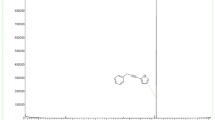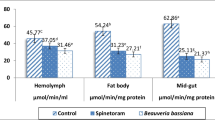Abstract
The success of Halyomorpha halys (Stål) as an invasive species in temperate climates is partly due to its ability to survive winter in a state of reproductive diapause. In H. halys, the termination of juvenile hormone (JH) production by the corpora allata, in response to a decline in day length, leads to the initiation of diapause and suspension of reproductive activity. Results of this study showed that topical application of the JH analog pyriproxyfen at doses of 0.05–100 μg per insect resulted in the resumption of oocyte formation and oviposition in a dose-dependent manner, with the ED50 estimated at 1.14 μg per insect. Eggs induced by pyriproxyfen application had significantly lower hatchability than control eggs. The indirect effects of host exposure to pyriproxyfen on the hymenopteran parasitoid Trissolcus japonicus (Ashmead), a candidate biological control agent of H. halys, were evaluated. When presented with eggs produced by pyriproxyfen-treated females, T. japonicus was observed ovipositing, but no adult parasitoids emerged from host eggs. Exposure to pyriproxyfen has the potential to lower the reproductive potential of H. halys populations by inducing the production of eggs with reduced viability during periods of low resource availability. The complete mortality of T. japonicus developing on pyriproxyfen-induced eggs suggests that insect growth regulators which interfere with host reproduction may exert a strong indirect effect on beneficial egg parasitoids, and may not be compatible with egg parasitoid biological control programs.




Similar content being viewed by others
References
Amiri A, Bandani AR, Darvishzadeh A (2012) Effects of the insect growth regulators methoxyfenozide and pyriproxyfen on adult diapause in sunn pest Eurygaster integriceps (Hemiptera: Scutelleridae). J Agric Sci Technol 14:1205–1218
Arakawa R, Miura M, Fujita M (2004) Effects of host species on the body size, fecundity, and longevity of Trissolcus mitsukurii (Hymenoptera: Scelionidae), a solitary egg parasitoid of stink bugs. Appl Entomol Zool 39:177–181. doi:10.1303/aez.2004.177
Bajgar A, Dolezel D, Hodkova M (2013a) Endocrine regulation of non-circadian behavior of circadian genes in insect gut. J Insect Physiol 59:881–886. doi:10.1016/j.jinsphys.2013.06.004
Bajgar A, Jindra M, Dolezel D (2013b) Autonomous regulation of the insect gut by circadian genes acting downstream of juvenile hormone signaling. Proc Natl Acad Sci USA 110:4416–4421. doi:10.1073/pnas.1217060110
Blaauw BR, Polk D, Nielsen AL (2015) IPM-CPR for peaches: incorporating behaviorally-based methods to manage Halyomorpha halys and key pests in peach. Pest Manag Sci 71:1513–1522. doi:10.1002/ps.3955
Bownes M (1989) The roles of juvenile hormone, ecdysone and the ovary in the control of Drosophila vitellogenesis. J Insect Physiol 35:409–413. doi:10.1016/0022-1910(89)90115-7
Charles J-P, Iwema T, Epa VC et al (2011) Ligand-binding properties of a juvenile hormone receptor, methoprene-tolerant. Proc Natl Acad Sci USA 108:21128–21133. doi:10.1073/pnas.1116123109
Cônsoli F, Conti E, Dangott L, Vinson S (2001) In vitro culture of the teratocytes of Trissolcus basalis (Hymenoptera, Scelionidae) and their requirements for host-derived components. Biol Control 22:176–184. doi:10.1006/bcon.2001.0964
Davey KG (1997) Hormonal controls on reproduction in female heteroptera. Arch Insect Biochem Physiol 35:443–453. doi:10.1002/(SICI)1520-6327(1997)35:4<443:AID-ARCH7>3.0.CO;2-S
Delbeke F, Vercruysse P, Tirry L et al (1997) Toxicity of diflubenzuron, pyriproxyfen, imidacloprid and diafenthiuron to the predatory bug Orius laevigatus (Heteroptera: Anthocoridae). Entomophaga 42:349–358. doi:10.1007/BF02769828
Denlinger DL (2002) Regulation of diapause. Annu Rev Entomol 47:93–122. doi:10.1146/annurev.ento.47.091201.145137
Desneux N, Decourtye A, Delpuech J-M (2007) The sublethal effects of pesticides on beneficial arthropods. Annu Rev Entomol 52:81–106. doi:10.1146/annurev.ento.52.110405.091440
Duan JJ, Prokopy RJ, Yin CM et al (1995) Effects of pyriproxyfen on ovarian development and fecundity of Rhagoletis pomonella flies. Entomol Exp Appl 77:17–21. doi:10.1111/j.1570-7458.1995.tb01980.x
El-Wakeil N, Gaafar N, Sallam A, Volkmar C (2013) Side effects of insecticides on natural enemies and possibility of their integration in plant protection strategies. In: Trdan S (ed) Insecticides—development of safer and more effective technologies. InTech, Rjeka, pp 3–56
Hahn DA, Denlinger DL (2011) Energetics of insect diapause. Annu Rev Entomol 56:103–121. doi:10.1146/annurev-ento-112408-085436
Hatakoshi M, Shono Y, Yamamato H, Hirano M (1991) Effects of the juvenile hormone analog pyriproxyfen, on Myzus persicae and Unaspis yanonensis. Appl Entomol Zool 26:412–414. doi:10.1303/AEZ.26.412
Haye T, Gariepy T, Hoelmer K et al (2015) Range expansion of the invasive brown marmorated stinkbug, Halyomorpha halys: an increasing threat to field, fruit and vegetable crops worldwide. J Pest Sci 88:665–673. doi:10.1007/s10340-015-0670-2
Hodek I (1971) Termination of adult diapause in Pyrrhocoris apterus (Heteroptera: Pyrrhocoridae) in the field. Entomol Exp Appl 14:212–222. doi:10.1111/j.1570-7458.1971.tb00158.x
Hoebeke ER, Carter ME (2003) Halyomorpha halys (Stål) (Heteroptera: Pentatomidae): a polyphagous plant pest from Asia newly detected in North America. Proc Entomol Soc Wash 105:225–237
Hsiao C, Hsiao TH (1969) Insect hormones: their effects on diapause and development of hymenoptera. Life Sci 8:767–774. doi:10.1016/0024-3205(69)90014-9
Inkley DB (2012) Characteristics of home invasion by the brown marmorated stink bug (Hemiptera: Pentatomidae). J Entomol Sci 47:125–130. doi:10.18474/0749-8004-47.2.125
Ishaaya I, Horowitz AR (1992) Novel phenoxy juvenile hormone analog (pyriproxyfen) suppresses embryogenesis and adult emergence of sweetpotato whitefly (Homoptera: Aleyrodidae). J Econ Entomol 85:2113–2117. doi:10.1093/jee/85.6.2113
Kotaki T, Yagi S (1989) Hormonal control of adult diapause in the brown-winged green bug, Plautia stali Scott (Heteroptera: Pentatomidae). Appl Entomol Zool 24:42–51. doi:10.1303/AEZ.24.42
Leskey TC, Hamilton GC, Nielsen AL et al (2012) Pest status of the brown marmorated stink bug, Halyomorpha halys in the USA. Outlooks Pest Manag 23:218–226. doi:10.1564/23oct07
Medina P, Smagghe G, Budia F et al (2003) Toxicity and absorption of azadirachtin, diflubenzuron, pyriproxyfen, and tebufenozide after topical application in predatory larvae of Chrysoperla carnea (Neuroptera: Chrysopidae). Environ Entomol 32:196–203. doi:10.1603/0046-225X-32.1.196
Milnes JM, Wiman NG, Talamas EJ et al (2016) Discovery of an exotic egg parasitoid of the brown marmorated stink bug, Halyomorpha halys (Stål) in the Pacific Northwest. Proc Entomol Soc Wash 118:466–470. doi:10.4289/0013-8797.118.3.466
Nettles WC Jr (1990) In vitro rearing of parasitoids: role of host factors in nutrition. Arch Insect Biochem Physiol 13:167–175. doi:10.1002/arch.940130304
Nielsen AL, Hamilton GC (2009) Life history of the invasive species Halyomorpha halys (Hemiptera: Pentatomidae) in northeastern United States. Ann Entomol Soc Am 102:608–616. doi:10.1603/008.102.0405
Nielsen AL, Shearer PW, Hamilton GC (2008) Toxicity of insecticides to Halyomorpha halys (Hemiptera: Pentatomidae) using glass-vial bioassays. J Econ Entomol 101:1439–1442. doi:10.1093/jee/101.4.1439
Numata H, Hidaka T (1984) Termination of adult diapause by a juvenile hormone analogue in the bean bug, Riptortus clavatus. Zool Sci 1:751–754
Ogburn EC, Bessin R, Dieckhoff C et al (2016) Natural enemy impact on eggs of the invasive brown marmorated stink bug, Halyomorpha halys (Stal) (Hemiptera: Pentatomidae), in organic agroecosystems: a regional assessment. Biol Control 101:39–51. doi:10.1016/j.biocontrol.2016.06.002
R Core Team (2015) R Core Team. R a lang. environ. stat. comput, vol 55. R Found. Stat. Comput., Vienna, pp 275–286. http://www.R-project.org/. ISBN: 3-900051-07-0
Rahat S, Gurr GM, Wratten SD et al (2005) Effect of plant nectars on adult longevity of the stinkbug parasitoid, Trissolcus basalis. Int J Pest Manag 51:321–324. doi:10.1080/09670870500312778
Ritz C, Streibig JC (2005) Bioassay analysis using R. J Stat Softw 12:1–22. doi:10.18637/jss.v012.i05
Rosenheim JA, Hoy MA (1988) Sublethal effects of pesticides on the parasitoid Aphytis melinus (Hymenoptera: Aphelinidae). J Econ Entomol 81:476–483. doi:10.1093/jee/81.2.476
Saber M, Hejazi MJ, Kamali K, Moharramipour S (2005) Lethal and sublethal effects of fenitrothion and deltamethrin residues on the egg parasitoid Trissolcus grandis (Hymenoptera: Scelionidae). J Econ Entomol 98:35–40. doi:10.1603/0022-0493-98.1.35
Saulich AK, Musolin DL (2012) Diapause in the seasonal cycle of stink bugs (Heteroptera, Pentatomidae) from the temperate zone. Entomol Rev 92:1–26. doi:10.1134/S0013873812010010
Saunders DS (1983) A diapause induction-termination asymmetry in the photoperiodic responses of the Linden bug, Pyrrhocoris apterus and an effect of near-critical photoperiods on development. J Insect Physiol 29:399–405. doi:10.1016/0022-1910(83)90067-7
Singh S, Kumar K (2015) Effects of juvenoid pyriproxyfen on reproduction and F1 progeny in myiasis causing flesh fly Sarcophaga ruficornis L. (Sarcophagidae: Diptera). Parasitol Res 114:2325–2331. doi:10.1007/s00436-015-4428-9
Stanley J, Preetha G (2016) Pesticide toxicity to parasitoids: exposure, toxicity and risk assessment methodologies. Pesticide toxicity to non-target organisms. Springer, Amsterdam, pp 99–152
Talamas EJ, Herlihy MV, Dieckhoff C et al (2015) Trissolcus japonicus (Ashmead) (Hymenoptera, Scelionidae) emerges in North America. J Hymenopt Res 43:119–128. doi:10.3897/JHR.43.4661
Varma GC, Singh PP (1987) Effect of insecticides on the emergence of Trichogramma Brasiliensis (Hymenoptera: Trichogrammatidae) from parasitized host eggs. Entomophaga 32:443–448. doi:10.1007/BF02373512
Volkoff N, Vinson SB, Wu ZX, Nettles WC (1992) In vitro rearing of Trissolcus basalis (Hym., Scelionidae an egg parasitoid of Nezara viridula (Hem., Pentatomidae). Entomophaga 37:141–148. doi:10.1007/BF02372982
Watanabe M (1979) Ecology and extermination of Halyomorpha halys 4: the relationship between day length and ovarian development. Annu Rep Toyama Inst Heal 3:33–37
Wermelinger B, Wyniger D, Forster B (2008) First records of an invasive bug in Europe: halyomorpha halys Stål (Heteroptera: Pentatomidae), a new pest on woody ornamentals and fruit trees? Bull la Soc Entomol Suisse 81:1–8
Yang ZQ, Yao YX, Qiu LF, Li ZX (2009) A new species of Trissolcus (Hymenoptera: Scelionidae) parasitizing eggs of Halyomorpha halys (Heteroptera: Pentatomidae) in China with comments on its biology. Ann Entomol Soc Am 102:39–47. doi:10.1603/008.102.0104
Zhu G, Bu W, Gao Y, Liu G (2012) Potential geographic distribution of brown marmorated stink bug invasion (Halyomorpha halys). PLoS ONE. doi:10.1371/journal.pone.0031246
Acknowledgements
The authors would like to thank Dr. Russ Mizell (University of Florida, NFREC, Quincy, Florida) for providing the H. halys specimens used in this study. We thank Dr. Julio Medal, Andy Santa-Cruz and Dr. Trevor Smith (FDACS-DPI, Gainesville, Florida) for providing their time, space, guidance and the parasitoids needed for this study. Helpful advice was provided by Dr. Joe Eger (Dow AgroSciences), Dr. Norm Leppla (University of Florida, Gainesville, Florida), Dr. Pete Andersen (University of Florida, NFREC, Quincy, Florida) and Dr. Ted Cottrell (USDA-ARS, Byron, GA). Finally, we would like to thank Jennifer Carr and the Biosecurity Research and Extension Laboratory at the University of Florida for assisting with experimental efforts.
Author information
Authors and Affiliations
Corresponding author
Ethics declarations
Conflict of interest
The authors declare that they have no conflict of interest.
Additional information
Communicated by D.C. Weber.
Special Issue: The brown marmorated stink bug Halyomorpha halys an emerging pest of global concern.
Rights and permissions
About this article
Cite this article
Penca, C., Hodges, A.C. Pyriproxyfen treatment terminates Halyomorpha halys reproductive diapause, with an indirect mortality effect on its egg parasitoid Trissolcus japonicus . J Pest Sci 90, 1269–1276 (2017). https://doi.org/10.1007/s10340-017-0882-8
Received:
Revised:
Accepted:
Published:
Issue Date:
DOI: https://doi.org/10.1007/s10340-017-0882-8




